Art & Exhibitions
Here Are 5 Women Artists Who Dominated Berlin Gallery Weekend, Despite Evidence of German Gender Bias
Sculptor Senga Nengundi and pop painter Evelyne Axell were among those getting the spotlight.
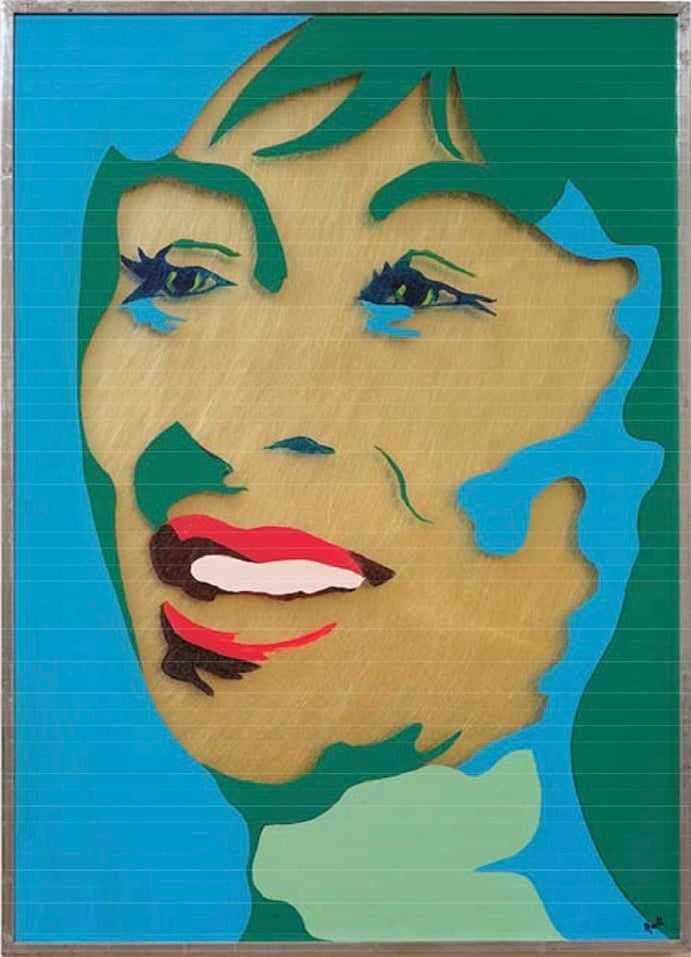
Sculptor Senga Nengundi and pop painter Evelyne Axell were among those getting the spotlight.

Kate Brown

Last Friday, some 47 galleries and a myriad more satellite shows opened their doors over Berlin’s Gallery Weekend, a preeminent event that sees invited collectors ushered from gallery to gallery around the city in private cars. Yet in the days leading up to the opening, a study was released about the subpar working conditions for the average artist in Berlin, touching off a flurry of discussions that inevitably punctured a hole in the weekend’s glamorous events.
In addition to putting hard numbers to the impoverished situation of Berlin-based artists, which particularly affect female artists, the study (lead by the Institute for Strategy Development) also confirmed that male artists are much more frequently represented in solo exhibitions throughout the city. Surprised?
At Gallery Weekend this year, the gender split was not quite balanced: Some 22 female artists were exhibited as solo or two-person shows out of the 58 solo or two-person exhibitions included on the official bill—far less than half. And yet, over the course of the weekend’s non-stop openings and receptions, the most buzzed-about exhibitions were decidedly in the female category. Many of these accomplished artists were even having their Berlin debuts.
The increased collective presence of these big presentations by women could almost be read as a statement—that is, if the distinct exhibitions were not so significant in and of themselves.
Here are artnet News’s highlight exhibitions from Gallery Weekend Berlin 2018.
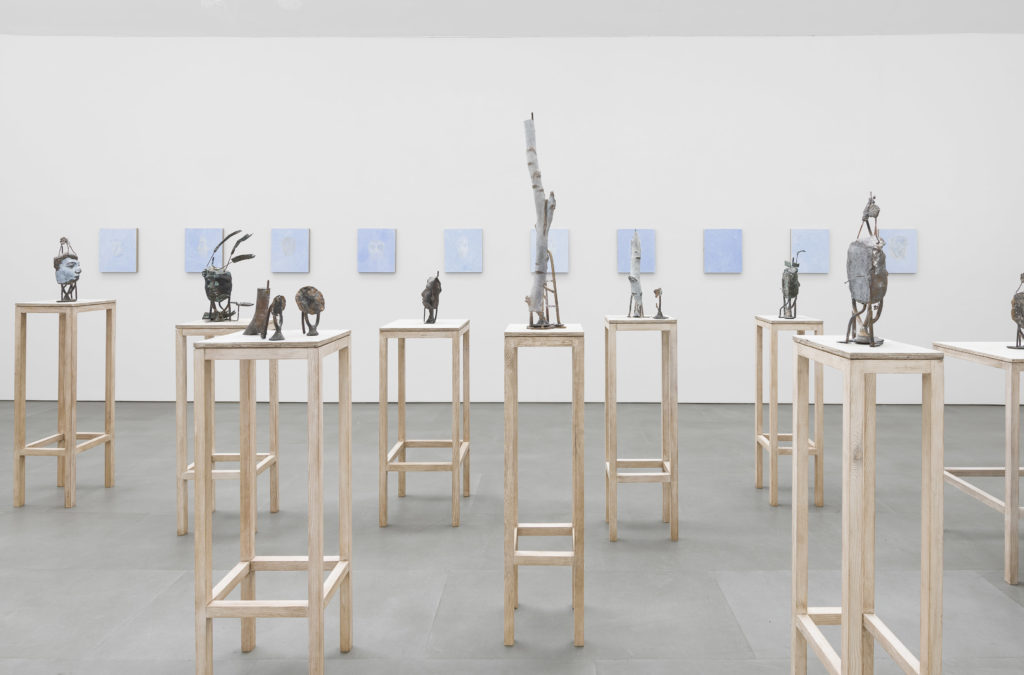
Cecilia Edefalk, the eight White Within angel, exhibition view at carlier | gebauer, 2018. Photo: Trevor Good.
Despite being one of the more revered artists in her home country of Sweden, 63-year old Cecilia Edefalk’s new show at carlier | gebauer is only her first solo exhibition in Berlin—a feat that feels long overdue. The show, titled “the eight White Within angel,” has a distinguished museum quality to it, with multiple bodies of works being presented throughout the gallery’s multi-room presentation. Though the press release claims that it is in fact not a retrospective, taken together the works in the show spans over 20 years.
In a fascinating look into several veins of her prolific practice, Edefalk includes an array of paintings and sculptures as serial forms, both large and small. As an exhibition, “the eight White Within angel” pieces together like a fragments of dream: A quiet boat of canvas and wood is moored in complete stillness; Multiple studies of entropic faces ripple across a collection of skeletal plinths. Everything feels slightly like an artifact, which is not to say that the work is not devoutly contemporary or avant-garde.
There are repeated motifs and symbols in Edefalk’s show, and they pour across the several painted panels in the main room in the form of eight abstract angels who give it its title. In fact, this particular series has come together here for the first time ever. With celestial lighting from the gallery’s large industrial skylights, this powerful body of work could not look better.
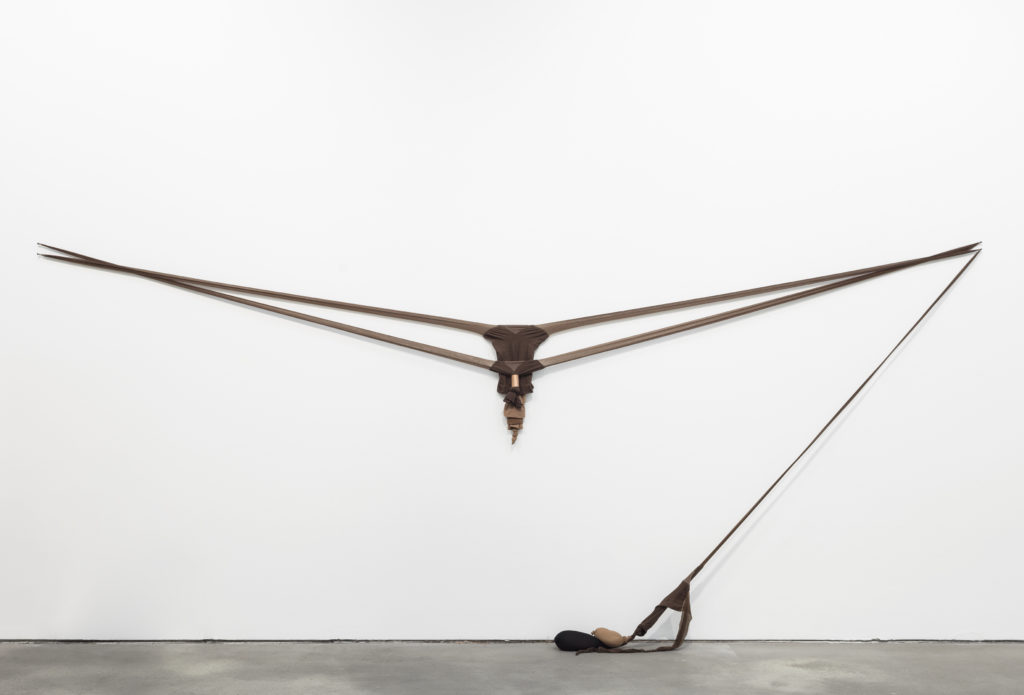
Senga Nengudi’s R.S.V.P. Reverie “D”, (2014). Courtesy of the Artist, Sprüth Magers, Thomas Erben Gallery, New Yorkand Lévy Gorvy Gallery, New York and London. Photo by Timo Ohler.
Though Senga Nengudi has been well-known in America for decades now, Berlin is only seeing the African-American artist’s first solo presentation now at Sprüth Magers. Nengudi was a seminal figure in the 1960s avant garde, with her roots on the West Coast, and the works on view span photographs from that time as well as four recent sculptures from her celebrated “R.S.V.P.” series, begun in the ’70s. These feature various stretched stockings splayed and weighted to the ground or tacked to the wall. It’s both a testament to the body of a dancer and feminine resiliency in formation or under duress.
A series of historic photographs from a 1978 performance entitled Ceremony for Freeway Fets include a young David Hammons and Maren Hassinger playing instruments and moving through choreography on an underpass with several other performers from Studio Z, a collective which Nengudi helped co-found with Hammons, Hassinger and others. This mysterious performance work today only exists through these historic images—even the costumes/props made from Nengudi’s signature stocking material seem to no longer exist.
The presentation runs concurrently with Kara Walker’s exhibition downstairs, featuring the explicit film Fall Frum Grace, Miss Pipi’s Blue Tale (2011). These two distinct voices of two vital American artists reverberate together.
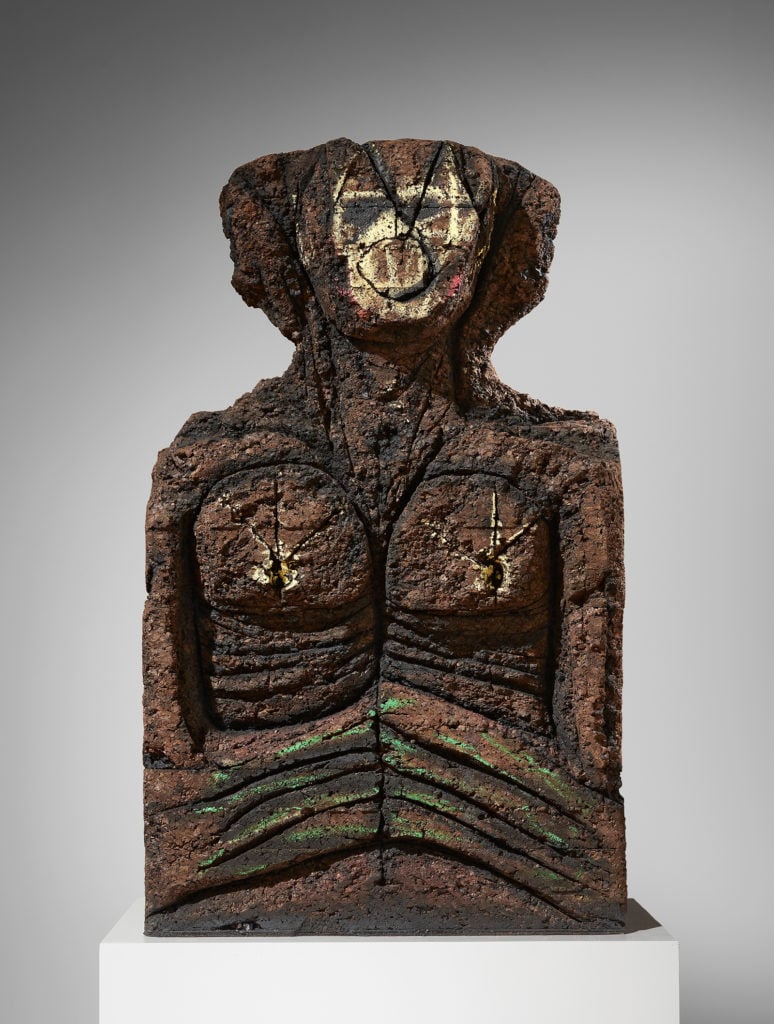
Huma Bhabha, 2 OF US, 2018. Courtesy Contemporary Fine Arts, Berlin. Photo: Matthias Kolb.
Just a week after Bhabha’s highly anticipated unveiling of her commissioned works We Come in Peace on the rooftop garden at the Metropolitan Museum in New York, the artist brings a force to Berlin at Contemporary Fine Arts with her first solo show there, “Revengers.”
The exhibition, which is completely dedicated to forms of portraiture whether as painted heads or as sculptural bust, using unlikely combinations of materials that feel decidedly post-apocalyptic or prehistoric.
The Pakistan-born artist, who lives and works outside of New York City in Poughkeepsie, shows a new series of vivid wall works, collages, and drawings made with various mediums including oil stick and pastels. They are geometric, wild, and ghostly.
Three cork busts and a leaning figurative sculpture are also on view made from wood, clay, wire, metal, or acrylic paint, among other materials. They recall Egyptian statues, a reference which suggests the tense commentary around restitution underway in Europe, but also modern European masters like Rodin, Brancusi, and Giacometti.
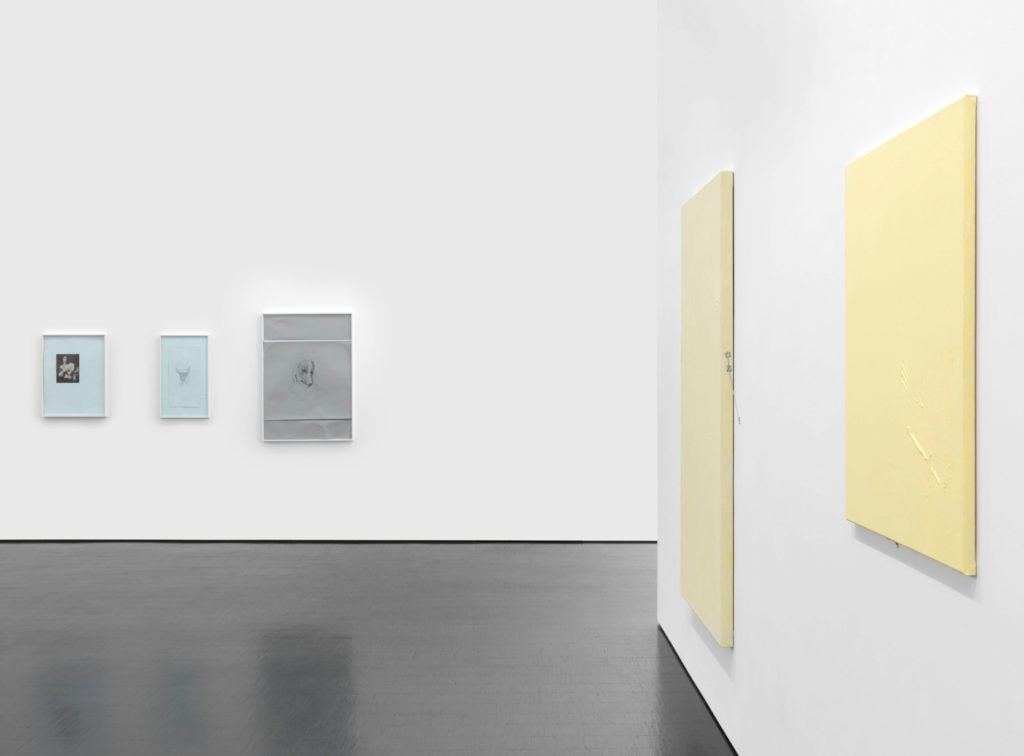
Installation view of Monika Baer’s Die Einholung at Galerie Barbara Weiss. Courtesy the artist and Galerie Barbara Weiss.
Though not a debut or a surprise appearance, the German painter Monika Baer’s new exhibition “Die Einholung” (translated: “The Request”) feels fresh and unexpected. For her sixth solo exhibition at Galerie Barbara Weiss, Baer pushes forward her penchant for crafting illusions through painting, while defying any set realities for understanding the medium.
Through three interrelated groups of paintings and drawings that riff of each other, the process behind her work is almost palpable. Each work seems to vibrate between various states: paintings edge toward the dimension of sculpture; Baer’s drawings, framed and transformed with folds and rips, border towards collage.
Baer’s enduring strength as an artist has been her capacity to use small touches to grand effects. The power of “Die Enholung” is in the small gestures of extra-large paint drips sculpted on the surface of smokey canvas, or by way of intricate fasteners that conspicuously strap the canvas to the wall. It is a delicate and masterful exhibition.
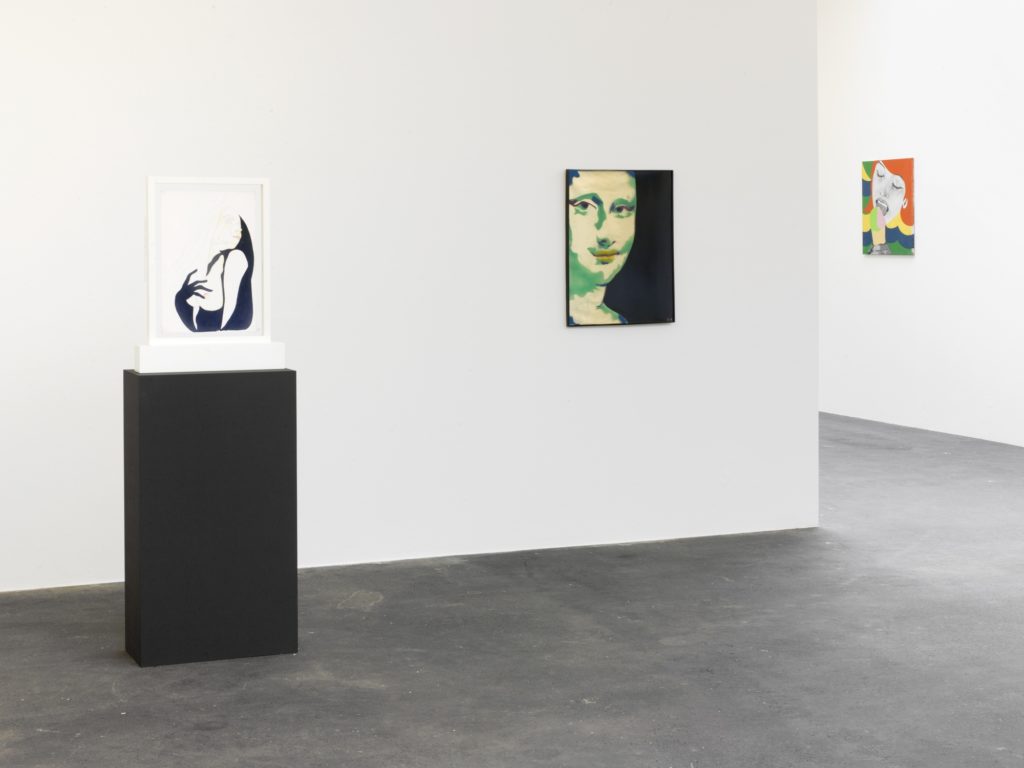
Installation view König Galerie, Dessauer Street. Photo by Roman März, image courtesy König Galerie.
In “Venus, Leda, & Mona Lisa,” the undersung but historically grounded Pop painter Evelyne Axell posthumously returns to Germany with a large exhibition that spans Johann König’s two locations. In her early years, the Belgian artist had visited surrealist René Magritte twice a month during the year of 1964, where she developed her unique oil painting technique before she began experimenting with enamel on her well-regarded cut-out panels.
To handle the task of managing Axell’s extensive body of work, the gallery enlisted Austrian curator Angela Stief, who has an ongoing relationship with the painter’s practice. Stief had curated Axell into a groundbreaking revisionist exhibition at Kunsthalle Vienna in 2011 entitled “Power Up—Female Pop Art” which featured Axell, Sister Corita, Dorothy Iannone, and Niki de Saint Phalle, among others.
At their location in the former St. Agnes church, the gallery is showing vibrant tropical painting series with cut-out forms of animals that extend beyond the boundaries of the frames. The show then extends to their former Dessauerstrasse location where some of works are on view for the first time, having been restored in collaboration with the artist’s estate, which is managed by her son.
Here, provocative celebrations of female sexuality abound. There is the most iconic woman of all, Mona Lisa, as a psychedelic rendering; there is the Spartan goddess Leda, and a nude self-portrait of the artist herself. Several drawn studies for paintings show Axell’s working process. Interwoven within these figurative works are a series of highly saturated images of women behind the wheel of cars or pressing down on the gas pedal with red heels. The latter feel particularly eery, considering the artist died in a tragic car accident outside of Ghent when she was only 37 years old.